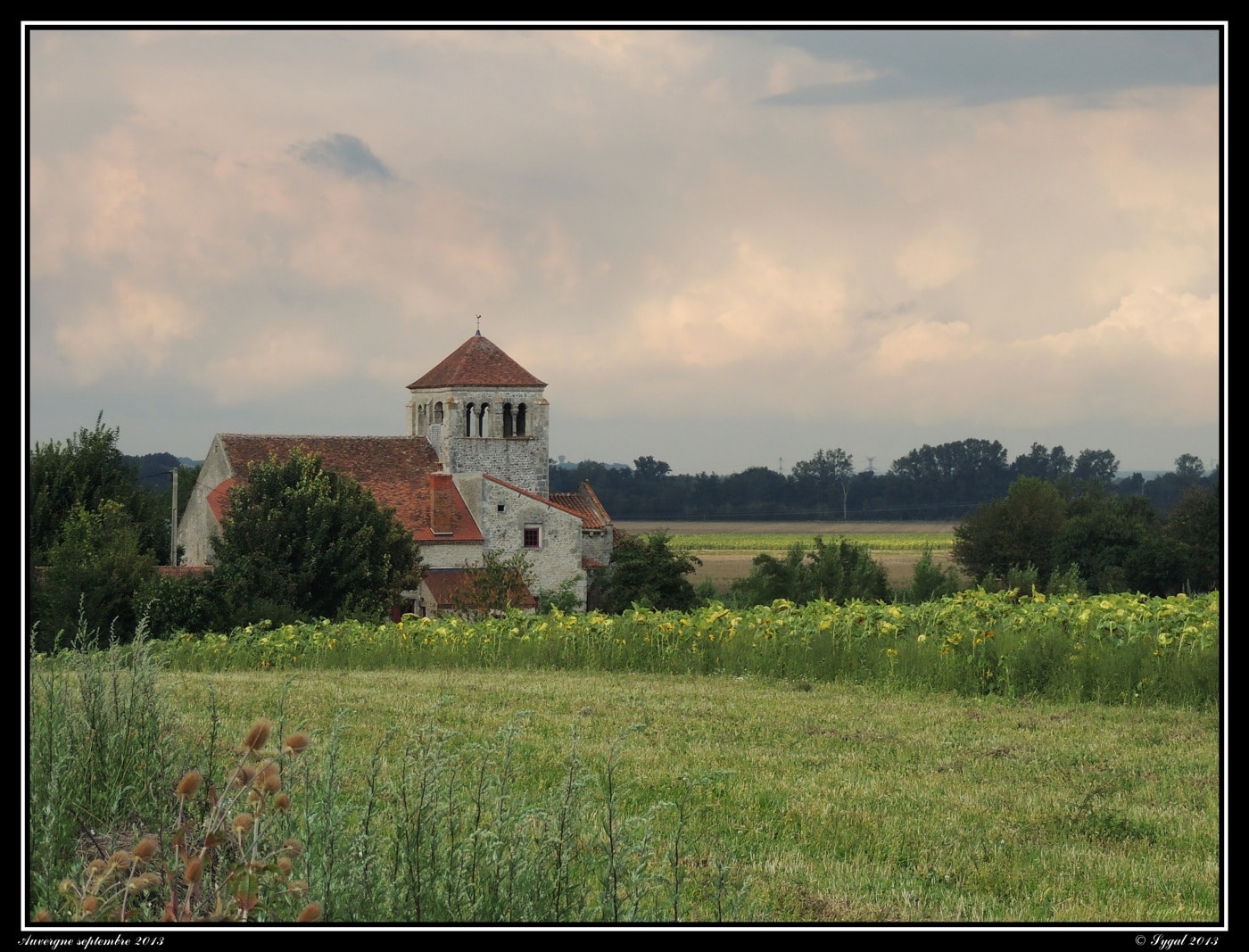Known as “La France profond,” (profound France), the Auvergne in central France, the country’s least populated region, may not rank high on the typical tourist’s itinerary. But for anyone who wants to discover the “real” France with tiny, picturesque villages, magnificent Romanesque churches, interesting towns, more than 300 kinds of cheeses – and beautiful countryside – this is the place.
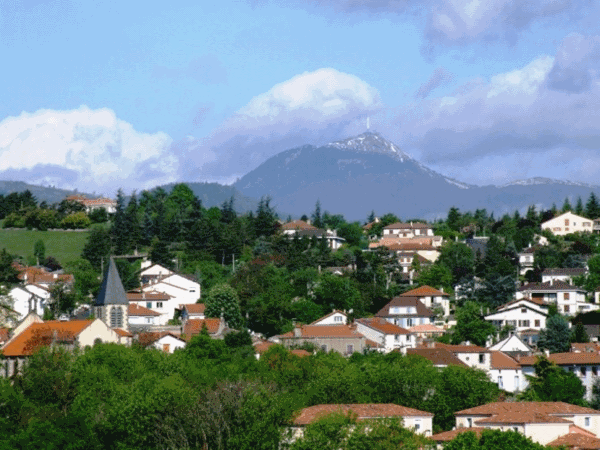
“It’s one of the last territories of France that has stayed authentic. It has not changed much,” says Alain Bozzo, who, with his wife Monique, runs a bed and breakfast on an old estate in the area. Coco Chanel, the fashion icon who brought us the little black dress, Chanel No. 5 perfume and that signature cardigan jacket, lived in different parts of the Auvergne until the age of 24 when she set off for Paris to launch her career. A region of long dormant volcanoes, Auvergne’s landscape is punctuated with hilltops that rise from the flats. “I am the last of the Auvergne volcanoes which is not extinct,” Coco Chanel had declared. She was feisty, independent, determined and way ahead of her time.
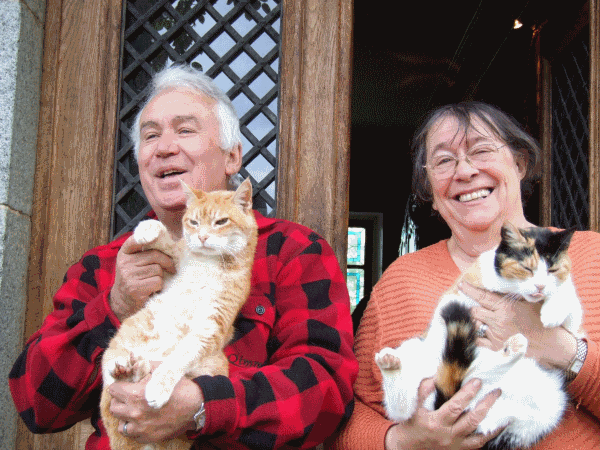
Her path to success defied tradition and is a fascinating rags to riches tale.
However this may be, there are few “Chanel was here” signs hanging in the Auvergne. You have to seek out the connections, which is a very interesting way to discover this pretty part of France which is surprisingly laid-back. Stroll through charming villages like Vichy and Moulins with their tourist attractions, and the capital, Clermont-Ferrand, which is a good place to begin. The city of 140,000, built on the butte of an ancient volcano, is known for the black/gray volcanic stone used to construct most of its buildings. Chanel was known to say that her hair was black like the city stone.
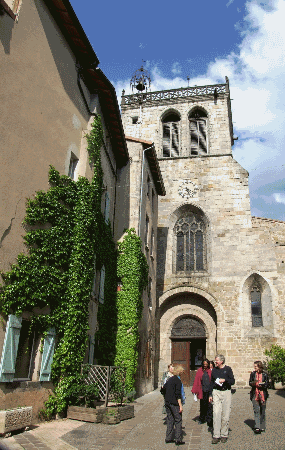
Clermont-Ferrand’s pièce de résistance is the cathedral, built from the 13th to the 19thcentury. The Gothic structure is a wonder, its black stone exterior giving it a dark and spooky atmosphere. With electric candle-like chandeliers barely lighting the aisles and vibrant hued stained glass windows in contrast, wandering the interior borders on a mystical experience. Unlike the dark cathedral, the recently completely restored Notre Dame de Port, is the town’s Romanesque jewel and declared a UNESCO World Heritage site. This church is bright, its walls a soft yellow and its columns noted for their capitals sculpted with figures depicting stories.
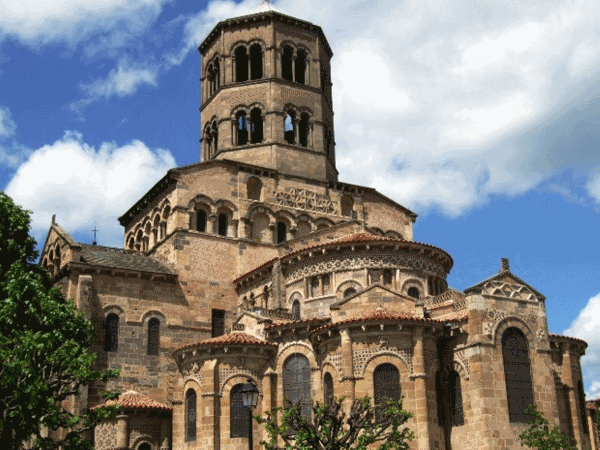
In the town of Issoire, where the Chanel family lived when she was a child, visit the Romanesque Abbatiale Saint Austremoine. The unique aspect of this church is its columns — all bright red. A guide explains that studies show the columns were originally this color when the church was constructed in the 12th century, and were returned to their original state in the restoration. Other bright colors decorate the column capitals – all with detailed sculptures of figures. It’s a bit of a shock, albeit a delightful one, to see a church in such bright and cheery tones especially bearing in mind Chanel’s preference for neutrals. Afterward, we stroll down a side street to see the Chanel family house, now occupied by a woman who has no idea that Coco resided there. Life goes on, I guess.
When Chanel was 12 years old, she discovered her mother, then age 33, dead in her room. Her father, a peddler who traveled from market to market to sell his goods and spent little time with the family, abandoned her and her four brothers and sisters. She was sent to a Catholic orphanage where life was strict and monotonous. At the age of 18, her independent spirit rebelled against the discipline and dull life. She set off to Moulins where she got a job as a seamstress in a shop selling baby clothes.
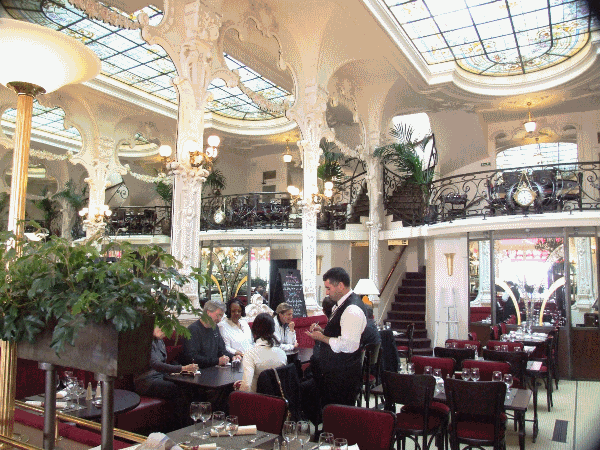
But she had grander ambitions. She wanted to be a singer. She found a night job at a cabaret, Le Grand Café, entertaining guests between acts by singing amusing songs. One of her songs, Qui qu’a vu Coco dans l’Trocadero (Who has seen Coco in Trocadero), earned her the name “Coco.” Today, Le Grand Café has been declared a historic monument and with its original décor of mirrored walls, stained glass ceiling, black iron tables and palms, it’s considered “one of the 10 most beautiful art deco cafes” in France.
The Moulins Cathedral of Notre Dame dates back to the end of the 15th century. It shields a precious treasure, the Master of Moulin triptych from 1502, a remarkable artwork, its three panels depicting the Annunciation in brilliant colors. A newer Moulins attraction outside the town in a former military barracks built during the reign of Louis XV is the National Center of Theater Costumes. It opened in 2006 and stages two different exhibitions each year of some of its collection of 10,000 garments. The current exhibit, “Collection Noureev,” runs until Jan. 5, 2014.
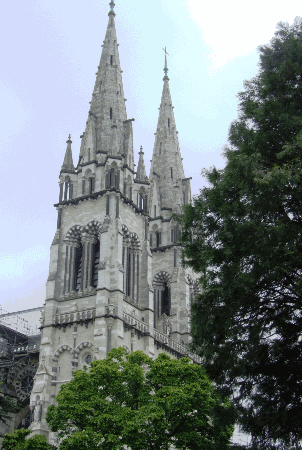
Coco left Moulins in 1907, never making it to the big stage, and moving next to Vichy where she tried again to be recognized as a singer. Once again she failed, but she discovered something else in the elegant spa town put on the map in the 19th century by Napoleon III who ordered the construction of a casino, chalets, boulevards and parks. During the Belle Époque, its Art Nouveau opera house, hippodrome, elegant thermal centers, and splendid parks were popular hangouts for the upper class that came to take the waters. Coco wanted to be part of this world of luxury. Thanks to her lover, a French officer and a wealthy horse breeder, she had an entrée.
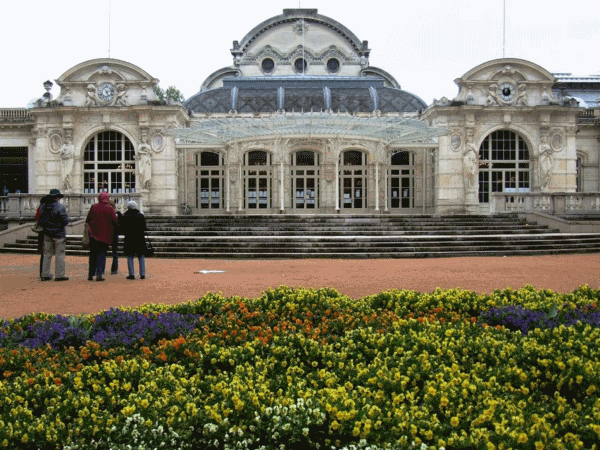
But she wanted more than to be a kept woman. Capitalizing on her talent with a needle and thread, she began making hats for wealthy matrons which were a sensation. With financial help from her lover, she moved to Paris and set up a millinery shop — the beginning of what would ultimately become the Chanel fashion empire.
Vichy has preserved its Belle Époque past. “It’s a little pearl in the center of France, a city stuck in time,” said one resident. Wandering through the leafy park (the city has 140 hectares of green space), past the opera house and Art Nouveau thermal center, it’s easy to imagine Coco Chanel in this ambience. In her early days here, she did in fact work at a spa dispensing water to help finance her singing lessons. Today, for 25 Euros, you can try a cup of mineral water at the Hall of Source.
It’s strange, but Vichy has neither monuments nor museums in memory of its darker side. During World War II it was the center of the right-wing government under Prime Minister Pétain after the country’s defeat by the Germans in June, 1940. The Vichy government cooperated with the Germans, imprisoning some 135,000 people, deporting 76,000 Jews and sending 650,000 French workers to Germany. “This is a city of pleasure,” commented a guide. After the demise of the Vichy regime, all remnants of it were destroyed in the town, she said. “People don’t like to discuss it,” she added.
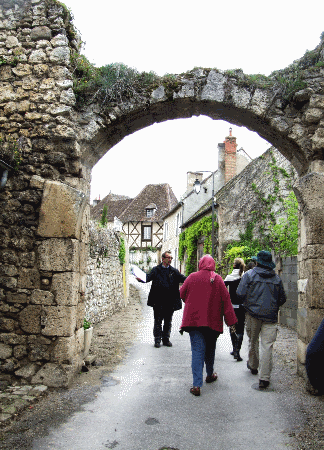
The medieval Auvergne village of Charroux, declared “one of the most beautiful villages in France,” has not one Chanel connection. But it’s still a must — a gem with its sections of old walls, towers and gates, as well as numerous quaint boutiques offering candles, lace, soap, pottery — and mustard. At one of the shops for the latter, a tiny place with an adjoining workshop where the mustard is made, we watched proprietor Olivier Maenner operate a giant mill stone to grind the seeds, then add a combination of vinegar, water and wine to make the final product. We tasted several varieties of the 20 different kinds of mustard Maenner produces. And, we made purchases, of course.
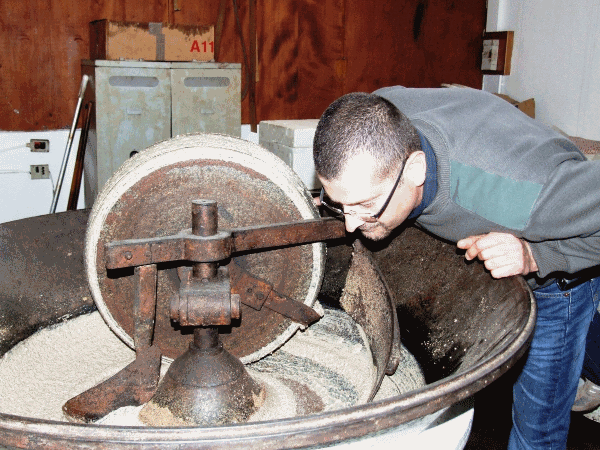
Once Chanel left the Auvergne, she rarely returned. She later acknowledged that her years there had a significant impact on her life. The “volcano” was extinguished in 1971 at the age of 87.
The area code for France is 33
Where to Stay:
Best Western Gergovie- In Pérignat les Sarliève just outside of Clermont Ferrand. Pleasant hotel with lovely views of the countryside and the Puy-de-Dôme, the highest peak (4,803 feet) of the dormant volcanoes. 25, Allee du Petit Puy, 63170 Clermont-Ferrand ; 33 (0) 4 73 79 09 95. www.hotel-gergovie-clermontferrand.com
Domaine de Gaudon- Outside of the town of Ceilloux. Alain and Monique Bozzo provide a warm welcome at this restored château where they run a bed and breakfast surrounded by picturesque countryside. Luxurious rooms tastefully decorated in period styles. Lavish breakfast. 63520 Ceilloux; 33 (0) 4 73 70 76 25; www.domainedegaudon.fr
Chateau de Maulmont- Located 30 minutes from Clermont Ferrand. Renovated, impressive château that is a hotel with a gastronomic restaurant. 63310 St. Priest, Bramefont, Randan; 33 (0) 4 70 59 14 95; www.chateau-maulmont.com
Chateau la Caniere- This hotel between Vichy and Clermont-Ferrand offers an elegant ambience with first-class amenities including a gourmet restaurant. Rue de la Croix Blanche, 63260 Thuret; 33 (0) 4 73 97 88 44; www.chateau-la-camiere.com
Le Clos de Bourgogne- 18th century hotel with restaurant. 83, rue de Bourgogne, 03000 Moulins, 33 (0) 4 70 44 03 10 www.closdebourgogne.fr
Where to Eat:
Brasserie du Casino- An elegant, art deco brasserie whose walls date back to 1897. At the turn-of-the century, it was a favorite for artists and those attending the opera located just across the street. 4, rue du Casino, 03200 Vichy; (0) 4 70 98 23 06; www.braserie-du-casion.fr/
Bistrot du Boucher Moulins- Discover turn-of-the century charm in this bistro which is legendary in Moulins. Both a cafe and brasserie serving from breakfast to dinner. 49 Place d’Alliers, 03000 Moulins, (0) 4 70 44 00 95. http://www.bistrotduboucher.fr/content/restaurant-40-bistrot-du-boucher-moulins-03000.htm
Le Diapason- Both a hotel and restaurant. The latter features “gastronomique”cuisine. Rue Clos de la Chaux, 63500 Le Broc ; (0) 4 73 71 71 71 ; lediapason.fr/index.php/en/
Bath’s- Excellent cuisine and service with the chic ambience of a “New York lounge.” Place St. Pierre, 63000 Clermont-Ferrand; (0) 4 73 31 23 22; www.baths.fr/
What to See and Do:
Vulcania- Learn more about volcanoes and have fun at this amusement park and museum offering numerous activities including interactive games based on the theme of water. Tour guides lead excursions inviting participants to crack the volcanoes’ secrets with games and hand-on exhibits. Route de Mazayes, F 63 230 Saint-Ours-Les-Roches; (0) 4 73 19 70; www.vulcania.com
Aventure Michelin- The two brothers who founded the famous tire company hailed from Clermont-Ferrand. The museum focuses on the work of the two brothers, industrial adventure and technological breakthroughs. 32 rue du Clos Four, 63 100 Clermont-Ferrand; (0)4 73 98 60 60; www.aventure-michelin.com
National Museum of Theater Costumes- This remarkable museum which opened in 2006 has more than 10,000 costumes in its collection. It stages two exhibitions yearly, each running for about six months. The current exhibit, “Collection Noureev,” runs until Jan. 5 2014. Quartier Villars, route de Montilly- 03000 Moulins; 04 70 20 76 20; www.cncs.fr
Domaine Gardien- The Auvergne produces wine. Taste the wines of Saint-Pourcain at this family winery. 7, Chassignolles, 03210 Besson; 04 70 42 80 11; www.domainegardien.com

